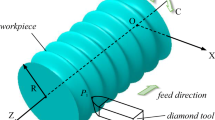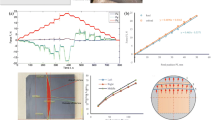Abstract
During the planar lightwave circuit (PLC) splitter manufacturing process, high precision is essential. Controlling machining precision is extremely difficult during the high-speed-and-precision dicing process, which is empirically related to the rotational speed, static diameter and elastic modulus of diamond dicing blades and other factors. However, the effect of changes in the outer diameter of blades on machining precision has been disregarded in the PLC manufacturing process. In this research, we proposed a dynamic diameter (Dd) for describing changes in a blade’s outer diameter during the high-speed machining process. Dd is positively correlated with machining precision. Here, we derived a formula for calculating Dd that is related to the rotational speed, static diameter, elastic modulus, Poisson’s ratio, density, cutting length and radial wear rate of diamond dicing blades. Furthermore, a series of experimental Dd values was obtained by changing the rotational speed, static diameter and elastic modulus of diamond dicing blades. These values are highly consistent with the calculated results. Our findings not only provide clues to compensate for diameter during high-speed-and-precision dicing process, but also offer guidelines for a new design route of diamond tools.










Similar content being viewed by others
Abbreviations
- Dd:
-
Dynamic diameter of a diamond dicing blade
- PLC:
-
Planar lightwave circuit splitters
- NCS:
-
Non Contact Setup
- FA:
-
Fiber Array
- AMP:
-
Amplifier
- A/D:
-
analogue to digital
- f :
-
Centrifugal force
- ρ c :
-
Density of a diamond dicing blade
- ρ m :
-
Density of metal binder
- ρ d :
-
Density of diamond
- ρ a :
-
Density of air pore
- ω :
-
Angular velocity
- r :
-
Radius
- V d :
-
volume fraction of a diamond in diamond dicing blade
- V a :
-
Volume fraction of air pore in a diamond dicing blade
- E c :
-
Young’s modulus of a diamond dicing blade
- E m :
-
Young’s modulus of metal binder
- E d :
-
Young’s modulus of diamond
- u :
-
Radial displacement of a rotary super-thin diamond blade
- h :
-
Thickness of a diamond dicing blade
- a :
-
Inner radius
- b :
-
Outer radius
- c :
-
Boundary of plastic area for a rotary diamond blade
- R d :
-
Dynamic radius of a high-speed rotary diamond blade
- D d :
-
Dynamic diameter of a high-speed rotary diamond blade
- D s :
-
Static diameter of a diamond blade
- V c :
-
Poisson’s ratio of a diamond dicing blade
- V m :
-
Poisson’s ratio of metal binder
- V d :
-
Poisson’s ratio of a diamond
- σ r :
-
Radial stress
- σθ :
-
Circumferential stress
- ε r :
-
Radial strain
- ε θ :
-
circumferential strain
- n :
-
Rotational speed
- l :
-
Cutting length of a diamond dicing blade
- k :
-
Radial wear rate of a diamond dicing blade
References
Uddin, M. A., Ali, M. Y., & Chan, H. P. (2009). Materials and fabrication issues of optical fiber array. Reviews on Advanced materials science, 21(2), 155–164.
Xie, J., Zhuo, Y. W., & Tan, T. W. (2011). Experimental study on fabrication and evaluation of micro pyramid-structured silicon surface using a V-tip of diamond grinding wheel. Precision Engineering, 35(1), 173–182.
Xie, J., Xie, H. F., Luo, M. J., Tan, T. W., & Li, P. (2012). Dry electro-contact discharge mutual-wear truing of micro diamond wheel V-tip for precision micro-grinding. International Journal of Machine Tools and Manufacture, 60(9), 44–51.
Xie, J., Feng, Y., & Cheng, J. (2015). Precision grinding of micro V-groove array on optical fiber quartz glass substrate. Optics and Precision Engineering, 23(8), 2243–2248.
EkhteraeiToussi, H., & Rezaei Farimani, M. (2012). Elasto-plastic deformation analysis of rotating disc beyond its limit speed. Pressure Vessels and Piping, 89(1), 170–177.
Shaowei, H. (2013). Study on the elastic-plastic interface and large deformation of axisymmetric disks under rotating status. Applied Clay Science, 79(7), 41–48.
Alexandrova, N., & Vila Real, P. M. M. (2006). Effect of plastic anisotropy onstress-strain field in thin rotating disks. Thin-Walled Structures, 44(8), 897–903.
Eraslan, A. N., & Orcan, Y. (2002). On the rotating elastic-plastic solid disks of variable thickness having concave profiles. Mechanical Sciences, 44(7), 1445–1466.
Aleksandrova, N. (2012). Application of Mises yield criterion to rotating solid disk problem. International Journal of Engineering Science, 51(2), 333–337.
Çallıoglu, H., Sayerb, M., & Demir, E. (2015). Elastic–plastic stress analysis of rotating functionally graded discs. Thin-Walled Structures, 94(1), 38–44.
Khalili, A., & Peddieson, J. (2014). Evaluation of elastic compensation using elastic/plastic rotating circular disk problems. Mechanics Research Communications, 55(1), 89–94.
Aleksandrova, N. (2014). Exact deformation analysis of a solid rotating elastic perfectly plastic disk. International Journal of Mechanical Sciences, 88(11), 55–60.
Hojjati, M. H., & Hassani, A. (2008). Theoretical and numerical analyses of rotating discs of non-uniform thickness and density. International Journal of Pressure Vessels and Piping, 85(10), 694–700.
Callıoglu, H., Topcu, M., & Tarakcılar, A. R. (2006). Elastic-plastic stress analysis of an orthotropic rotating disc. International Journal of Mechanical Sciences, 48(9), 985–990.
Yao, B., Tan, X., & He, W. (2011). Influence of centrifugal force of grinding wheel on grinding precision. Mechanical & Electrical Technology, 34(5), 36–38.
Liu, Y., Fan, J., & Li, Y. (2013). Compensation technology of grinding deformation for engine camshaft. Transactions of the Chinese Society of Agricultural, 44(6), 274–278.
Zhang, L., & Xu, X. (2010). Influences of grinding speed and on the grinding wheel’s strength and deformation. Applied Science and Technology, 37(7), 35–38.
Pang, Z., Hu, X., Wang, W., & Liu, Y. (2008). Optimization of wheel hub based on high speed and ultra high speed grinding. Mechanical Engineering & Automation., 149(4), 4–9.
Cao, H., Li, B., Chen, X., & He, Z. (2012). Centrifugal expansion of high-speed spindle and its influences on bearing dynamic characteristics. Journal of Mechanical Engineering, 48(19), 59–64.
Ma, Y., & Yuan, H. (2009). Research of performance and three-dimensional modeling of diamond blade. Instrument Technique and Sensor, supplement, 4, 274–275.
Tawakoli, T., Reinecke, H., & Vesali, A. (2012). An experimental study on the dynamic behavior of grinding wheels in high efficiency deep grinding. Procedia CIRP, 1(1), 382–387.
Barlow, N., Jackson, M. J., Millst, B., & Rowe, W. B. (1995). Optimum clamping of C.B.N and conventional vitreous-bonded cylindrical grinding wheels. International Journal of Machine Tools and Manufacture, 35(1), 119–132.
Brinksmeier, E., Mutlugunes, Y., Klocke, F., & Aurich, J. C. (2010). Ultra-precision grinding. CIRP Annals-Manufacturing Technology, 59(2), 652–671.
Topcu, I. B., Bilir, T., & Boga, A. R. (2010). Estimation of the modulus of elasticity of slag concrete by using composite materials models. Construction and Building Materials, 24(5), 741.
Vendra, L., & Rabiei, A. (2010). Evaluation of modulus of elasticity of composite metal foams by experimental and numerical techniques. Materials Science and Engineering A, 527(7–8), 1784–1790.
Gupta, R., Sulaiman, N., Beg, M. D. H., & Gupta, A. (2012). An enhanced model for prediction of young modulus of composite. Procedia Technology, 1(10), 303–307.
Madan, Royal, Bhowmick, Shubhankar, & Saha, K. N. (2018). Stress and deformation of functionally graded rotating disk based on modified rule of mixture. Materials Today, Proceedings, 5, 17778–17785.
Khorsand, M., & Tang, Y. (2018). On the qualitative dynamics of rotating disks: Thermal shocks and structural integrity. International Journal of Pressure Vessels and Piping, 166(09), 35–47.
Mahdavi, E., Ghasemi, A., & Alashti, R. A. (2016). Elastic–plastic analysis of functionally graded rotating disks with variable thickness and temperature-dependent material properties under mechanical loading and unloading. Aerospace Science and Technology, 59(10), 57–68.
Khanna, K., Gupta, V. K., & Nigam, S. P. (2017). Creep analysis in functionally graded rotating disc using tresca criterion and comparison with von-Mises criterion. Materials Today, Proceedings, 4, 2431–2438.
Acknowledgements
This project was sponsored by the Natural Science Foundation of Hebei Province of China (E2016203425) and the Key Projects of Scientific and Technological Research in Hebei Province (ZD2017074). This work was also supported by Zhengzhou Research Institute for Abrasives and Grinding Co. Ltd. and Yanshan University.
Author information
Authors and Affiliations
Corresponding author
Additional information
Publisher's Note
Springer Nature remains neutral with regard to jurisdictional claims in published maps and institutional affiliations.
Rights and permissions
About this article
Cite this article
Li, K., Wang, M., Chen, F. et al. Analysis of the Dynamic Diameter of Superthin Diamond Blades in the High Speed and Precison Dicing Process. Int. J. Precis. Eng. Manuf. 20, 1071–1081 (2019). https://doi.org/10.1007/s12541-019-00128-7
Received:
Revised:
Accepted:
Published:
Issue Date:
DOI: https://doi.org/10.1007/s12541-019-00128-7




